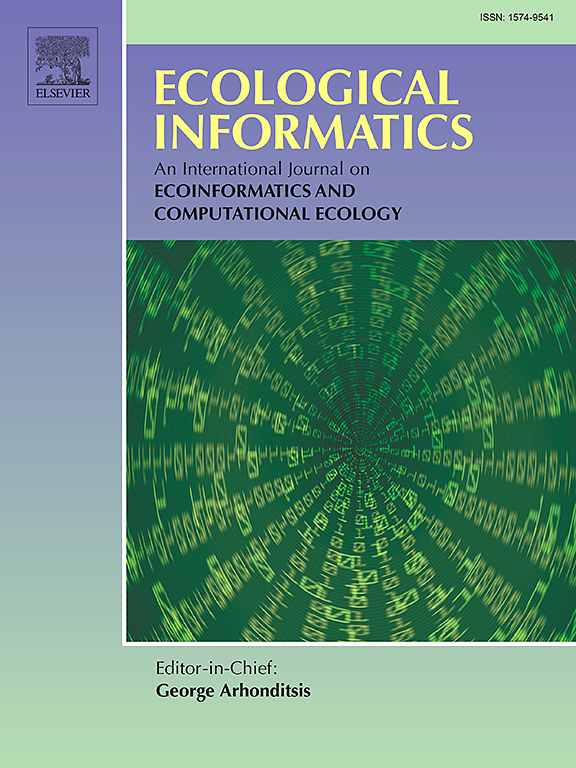Information extraction of seasonal dissolved oxygen in urban water bodies based on machine learning using sentinel-2 imagery: An open access application in Baiyangdian Lake
IF 7.3
2区 环境科学与生态学
Q1 ECOLOGY
引用次数: 0
Abstract
Water bodies are crucial components of urban ecology. The development of rapid and timely water-quality assessment tools using easily measured variables is essential for the health management of urban water bodies. In this study, we focused on the dissolved oxygen (DO) of Baiyangdian Lake using 251 sets of empirically measured water quality data and corresponding Sentinel-2 satellite images. Nine machine learning algorithms were then used to develop a rapid detection algorithm for the spatial distribution of the DO concentration in Baiyangdian Lake. This study successfully applied these methods to invert the DO concentration in Baiyangdian Lake during spring, summer, and autumn. The results indicated that extra tree regression (ETR) provided the most accurate and stable results for inverting the DO concentration among the nine machine learning methods. In contrast, AdaBoost regression (ABR), Bayesian ridge regression (BRR), and support vector machines (SVM) exhibit relatively poor regression performance and lack sensitivity to DO concentrations. Moreover, the DO concentration in Baiyangdian Lake ranged from approximately 0 to 12 mg/L, with notable spatiotemporal variations. The highest overall DO concentration was observed in the spring, particularly in the southern region. The DO concentration significantly decreased during summer compared to that in spring, with higher values in the southwestern area and lower values in the northern region. The DO concentration reached its lowest value in autumn, with slightly higher values in the southern region. This study focused on the estimation and inversion of DO concentrations in the water bodies of Baiyangdian Lake. By introducing and comparing the performances of commonly used machine learning models, a rapid estimation of the DO concentration was achieved, thereby overcoming the limitations of traditional water quality monitoring methods in DO inversion. It not only intuitively explained the temporal and spatial variation patterns of DO concentration but also laid a foundation for further in-depth exploration of the interactions between DO and other water quality parameters.基于机器学习的城市水体季节性溶解氧信息提取--利用哨兵-2 图像:白洋淀的公开应用
水体是城市生态的重要组成部分。利用易于测量的变量开发快速、及时的水质评估工具对于城市水体的健康管理至关重要。在本研究中,我们利用 251 组经验测量的水质数据和相应的哨兵-2 卫星图像,重点研究了白洋淀的溶解氧(DO)。然后使用九种机器学习算法开发了白洋淀溶解氧浓度空间分布快速检测算法。该研究成功地应用这些方法反演了白洋淀春、夏、秋三季的溶解氧浓度。结果表明,在九种机器学习方法中,额外树回归(ETR)反演溶解氧浓度的结果最准确、最稳定。相比之下,AdaBoost 回归(ABR)、贝叶斯脊回归(BRR)和支持向量机(SVM)的回归性能相对较差,对溶解氧浓度缺乏敏感性。此外,白洋淀的溶解氧浓度范围约为 0 至 12 mg/L,时空变化明显。春季的溶解氧浓度最高,尤其是南部地区。与春季相比,夏季溶解氧浓度明显下降,西南部地区浓度较高,北部地区浓度较低。秋季溶解氧浓度达到最低值,南部地区略高。本研究重点关注白洋淀水体溶解氧浓度的估算和反演。通过引入和比较常用机器学习模型的性能,实现了溶解氧浓度的快速估算,从而克服了传统水质监测方法在溶解氧反演中的局限性。它不仅直观地解释了溶解氧浓度的时空变化规律,而且为进一步深入探讨溶解氧与其他水质参数之间的相互作用奠定了基础。
本文章由计算机程序翻译,如有差异,请以英文原文为准。
求助全文
约1分钟内获得全文
求助全文
来源期刊

Ecological Informatics
环境科学-生态学
CiteScore
8.30
自引率
11.80%
发文量
346
审稿时长
46 days
期刊介绍:
The journal Ecological Informatics is devoted to the publication of high quality, peer-reviewed articles on all aspects of computational ecology, data science and biogeography. The scope of the journal takes into account the data-intensive nature of ecology, the growing capacity of information technology to access, harness and leverage complex data as well as the critical need for informing sustainable management in view of global environmental and climate change.
The nature of the journal is interdisciplinary at the crossover between ecology and informatics. It focuses on novel concepts and techniques for image- and genome-based monitoring and interpretation, sensor- and multimedia-based data acquisition, internet-based data archiving and sharing, data assimilation, modelling and prediction of ecological data.
 求助内容:
求助内容: 应助结果提醒方式:
应助结果提醒方式:


